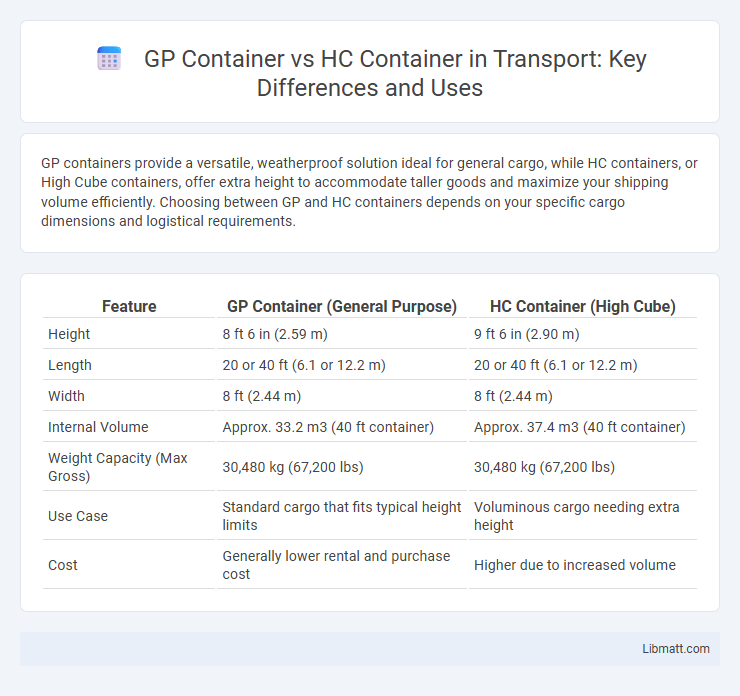GP containers provide a versatile, weatherproof solution ideal for general cargo, while HC containers, or High Cube containers, offer extra height to accommodate taller goods and maximize your shipping volume efficiently. Choosing between GP and HC containers depends on your specific cargo dimensions and logistical requirements.
Table of Comparison
| Feature | GP Container (General Purpose) | HC Container (High Cube) |
|---|---|---|
| Height | 8 ft 6 in (2.59 m) | 9 ft 6 in (2.90 m) |
| Length | 20 or 40 ft (6.1 or 12.2 m) | 20 or 40 ft (6.1 or 12.2 m) |
| Width | 8 ft (2.44 m) | 8 ft (2.44 m) |
| Internal Volume | Approx. 33.2 m3 (40 ft container) | Approx. 37.4 m3 (40 ft container) |
| Weight Capacity (Max Gross) | 30,480 kg (67,200 lbs) | 30,480 kg (67,200 lbs) |
| Use Case | Standard cargo that fits typical height limits | Voluminous cargo needing extra height |
| Cost | Generally lower rental and purchase cost | Higher due to increased volume |
Introduction to GP and HC Containers
GP containers, or General Purpose containers, offer versatile and cost-effective storage solutions suitable for a wide range of applications, providing balanced performance and scalability. HC containers, or High Capacity containers, specialize in maximizing storage space, ideal for archiving large volumes of data or supporting heavy backup environments. Choosing the right container type depends on your specific needs for performance, storage capacity, and workload characteristics.
Defining General Purpose (GP) Containers
General Purpose (GP) containers are designed to handle a wide range of workloads with balanced CPU, memory, and storage resources, making them versatile for various applications. Unlike High Computing (HC) containers that prioritize intensive processing tasks, GP containers provide flexibility for mixed-use scenarios, including web services, databases, and development environments. Your deployment benefits from GP containers when you need cost-effective, scalable infrastructure without the specialized performance requirements of HC containers.
Understanding High Cube (HC) Containers
High Cube (HC) containers offer an extra foot in height compared to standard General Purpose (GP) containers, providing approximately 9.5 feet of internal height versus 8.5 feet, maximizing vertical storage capacity. These containers are ideal for shipping lightweight, voluminous goods, optimizing space efficiency without increasing footprint dimensions. Understanding HC containers helps businesses choose the right container type for cargo requiring additional height, reducing shipping costs through better load management.
Key Differences: GP vs HC Container
GP containers offer versatile storage solutions ideal for general-purpose cargo, featuring a standard design that supports a wide range of goods. HC containers provide increased internal height compared to GP containers, making them suitable for bulky or tall items that require extra vertical space. Choosing between GP and HC containers depends on Your cargo dimensions and the need for additional height to optimize loading efficiency.
Dimensions and Capacity Comparison
GP containers typically measure 20 feet or 40 feet in length with a standard width of 8 feet and height of 8.5 feet, offering capacities of approximately 33 to 67 cubic meters. HC containers, also known as High Cube containers, share the same length and width but feature an increased height of 9.5 feet, providing around 76 to 86 cubic meters of capacity. When selecting between these options, your choice largely depends on the volume and types of goods, where HC containers maximize vertical space for larger or bulkier shipments.
Benefits of Using GP Containers
GP containers offer enhanced durability and scalability for cloud storage, supporting automated lifecycle management and tiered storage options that optimize cost and performance. These containers integrate seamlessly with Azure Blob Storage, enabling high availability and geo-redundancy to protect critical data. Leveraging GP containers improves access speed through reduced latency and supports complex workloads with consistent throughput and low transaction costs.
Advantages of HC Containers
HC containers offer superior insulation and durability compared to GP containers, making them ideal for transporting temperature-sensitive goods. These containers feature advanced thermal barriers that maintain consistent internal conditions, reducing spoilage and product loss. Their reinforced structure also provides enhanced protection against environmental stresses and impacts during transit.
Common Uses and Applications
GP containers are commonly used for general-purpose storage and transportation of goods, including bulk materials, liquids, and packaged products, making them versatile across various industries such as retail, manufacturing, and logistics. HC containers, designed with extra height, are ideal for transporting oversized or lightweight, voluminous cargo like furniture, machinery, and large boxes, optimizing your shipping capacity. Both container types support global supply chain efficiency, but selecting the right container depends on your cargo dimensions and weight requirements.
Choosing the Right Container Type
Choosing the right container type depends on your specific storage and transportation needs, where GP (General Purpose) containers offer versatile, weatherproof solutions ideal for most cargo types. HC (High Cube) containers provide an extra foot of height, making them perfect for bulky or lightweight volumes that require more vertical space. Consider your shipment dimensions and volume to optimize space, reduce costs, and ensure the safety of your goods.
Conclusion: GP Container vs HC Container Selection
GP containers offer versatile storage solutions with enhanced durability and cost-efficiency, making them ideal for general cargo and long-term usage. HC containers provide increased internal height, optimizing space for bulky or voluminous goods, which is essential for maximizing shipping efficiency. Your selection should depend on cargo dimensions and handling requirements, ensuring optimal container utilization.
GP container vs HC container Infographic

 libmatt.com
libmatt.com